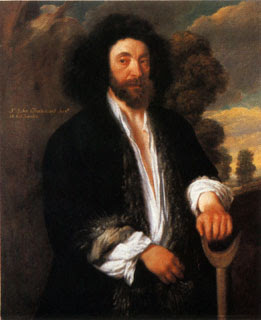 |
The Biodiversity Heritage Library has digitized the
Smithsonian Libraries copy of the Musaeum
Tradescantianum (link here)
|
Musaeum Tradescantianum, or, A collection of rarities preserved at South-Lambeth neer London, published in 1656, is a catalog of curiosities and trees, shrubs and plants assembled by father and son, both named John Tradescant, from far-flung trips. This printing of the contents of the house and gardens, dubbed the Ark, was paid for by Elias Ashmole, who, in turn, under murky circumstances, acquired it all, forming the nucleus of Oxford University’s famous Ashmolean Museum.
In the gardens and orchards of the Thames River estate, in the borough of Lambeth, the Tradescants grew over 700 botanical specimens. John the elder (approximately 1570-1638) and John the younger (1608-1662) were gardeners to a succession of nobility and royalty and, owing to these wealthy patronages, plant explorers. Tradescant senior journeyed to the Low Countries and France beginning in 1609 for Robert Cecil’s gardens at Hatfield House (limes, mulberries, cherries, tulips were acquired). He accompanied Sir Dudley Digges to Russia (1618), introducing the larch tree to England, and also explored North Africa (from 1620), returning with Syringa persica (Lilac). Tradescant oversaw the grounds of Oatlands in Surrey for King Charles I and Queen Henrietta Maria; his son succeeded him there as Keeper of His Majesty’s Gardens, Vines, and Silkworms. |
| John Tradescant’s house at south Lambeth. Line engraving, 1798 (photograph from Wellcome Images) |
 |
| A posthumous oil portrait of John Tradescant the Elder, attributed to Cornelis de Neve. The trompe-l’oeil cartouche contains grapes, pear, peaches, plums, parsnips, turnips, onions, tulips, and shells in a fitting tribute. (Photograph from the Ashmolean, Museum of Art and Archaeology,University of Oxford) |
 |
| Portrait of John Tradescant the Younger, attributed to Thomas de Critz. A wonderful romantic and melancholy presentation of the gardener, with his spade. (Photograph from the Ashmolean, Museum of Art and Archaeology,University of Oxford) |
North American botanical specimens were not the only curiosities attracting the Tradescants. Objects came into the collection, not only from the father and son’s journeys, but also from fellow travelers, sea captains, military officers, and diplomats. There were wonders in the Ark: a piece of Christ’s cross, a hand of a mermaid, a unicorn’s horn that Tradescant knew was from a narwhal but believed to be “yet very precious against poison.” Listed
in the Musaeum Tradescantianum were
“Divers Humming Birds, three sorts whereof are from Virginia.” And, “Pohatan,
King of Virginias habit [cloak] all
embroidered with shells, or Roanoke.” The 1901 Annual Report of the Board of Regents of the Smithsonian Institution proudly, if not entirely accurately,
boasts “The collections of Sloane, who was one of the early scientific
explorers of America, were like those of the Tradescants, contained many New
World specimens, and the British Museum as well as the Ashmolean was built
around a nucleus of American material.”
The Ark’s various collections of weapons, garments, coins,
“fourfooted beasts,” birds, insects, fishes, fossils, minerals, instruments,
works of art, all numerated in the Musaeum
Tradescantianum, are of course the type that are housed, cataloged, studied
and displayed in the Smithsonian. Along with the curious public (there are many
contemporary accounts), visitors of more serious interests soon started
referencing and studying the holdings. Schoolmaster Charles Hoole believed that
every child should pay an annual visit. Thomas Johnson, in his edition of
Gerard’s Herbal, noted that “Indian
Morrice Bells” could be seen at South Lambeth. The dodo, penguin, “Brazilian
Merula or blackbird,” and “Indian Mockbird” were studied by the ornithologist
Francis Willughby and naturalist John Ray.
The 1656 catalog was a unique publication in England for the
time. Materials were divided into two categories, “Naturall” and
“Artificialls”. The Musaeum
Tradescantianum is particularly important as a detailed record of the
gardens, long since destroyed. The main residence of the Tradescants, Turret
House, survived until 1881. Oxford’s Bodleian Library contains some of the
gardeners’s manuscripts and books, including the wonderful manuscript “Tradescant’s Orchard”, watercolors of fruit, and the only known copy of the 1634 Plantarum in horto Johannem Tradescanti
nascentium catalogus.
The Tradescants’ collection of the Ark in the Ashmolean is
now mostly dispersed. Even the Tradescant Dodo was thrown into a trash bonfire
in 1755 although the head and a leg were rescued and displayed in the Oxford
University Museum of Natural History. Today the Garden Museum (near the
original estate), with funding from the Ashmolean Museum, is working toward a
partial recreation of the Ark. The Musaeum
Tradescantianum provides the guidebook to the Tradescants’s Cabinet of
Wonders, a 17th-century precursor to the collections of the Smithsonian.
Notes:
The portrait engravings in the Musaeum Tradescantianum were by the famous Wenceslaus Hollar, a
family friend.
The Garden Club of Virginia honored both the Tradescants and
their state with a stain glass window of the family's coat of arms within a
wreath of Tradescantia virginiania, presented
to Oxford University in 1926. The generic name Tradescantia dates from 1718 and was recognized by Linnaeus. The
stain glass resides in the Museum of the History of Science (Old Ashmolean
Building). Photograph by Andrew Gray (Wikimedia Commons).
 |
| Tradescantia pallida 'Purple Heart'. Collected by Robert Bruce Faden for the Botany Department of the National Museum of Natural History, Smithsonian Institution. Photograph by Leslie Brothers |
Allan, Mea. The Tradescants: their plants, gardens and museum, 1570-1662. London: Michael
Joseph, 1964.
Leith-Ross, Prudence. The John Tradescants: gardeners to the Rose and Lily Queen. London: Peter Owen,
1984.
Julia Blakely, Special Collections Cataloger
Smithsonian Libraries
Julia Blakely, Special Collections Cataloger
Smithsonian Libraries











No comments:
Post a Comment